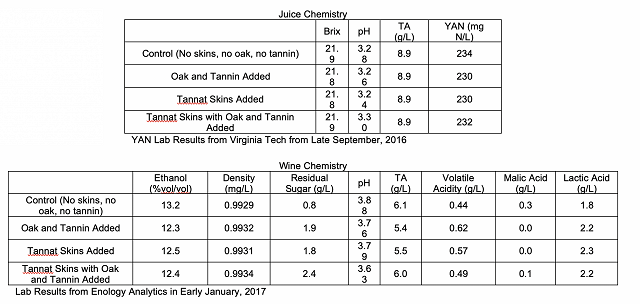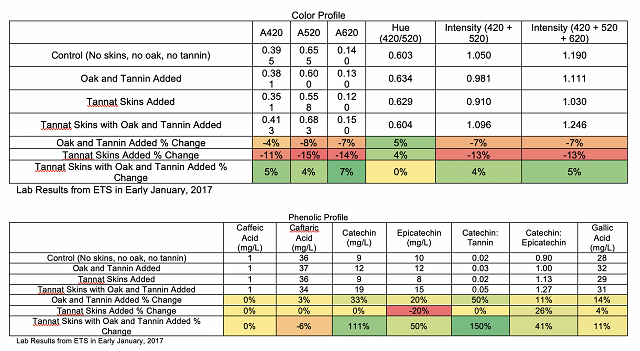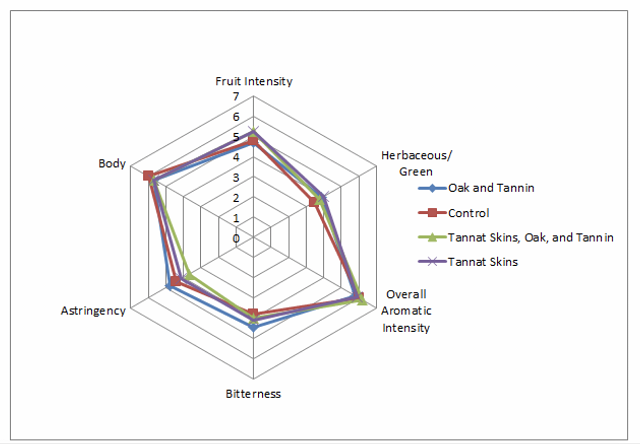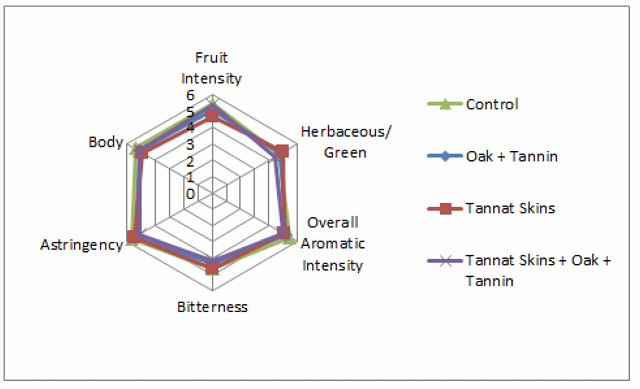The Effect of Adding Tannat Skins and Exogenous Tannin to Chambourcin Fermentations (2016)
Meaghan Tardif
Fabbioli Cellars
Summary
This study examines the impact that different sources of fermentation tannins will have on the sensory and phenolic qualities of Chambourcin wine. Chambourcin picked at the same time from the same block were crushed and destemmed into four fermentation bins, each with 1.5 tons of grapes. One bin was a control with no exogenous tannin added; the second bind received oak chips and fermentation tannins (Color Max and FT Rouge); the third bin received 75 pounds of Tannat skins; and the fourth bin received oak chips, fermentation tannins, and Tannat skins. All other treatments between lots were the same. In general, adding oak and tannat skins lowered color and phenolic attributes, except that tannin was slightly increased. Adding these compounds seemed to increase catechin and epicatechin. Adding Tannat skins and oak chips together increased catechin and epicatechin and slightly increased color intensity. Descriptors were mixed, and not too many differences could be seen between wines with the descriptors used in this study. In general, judges tended to prefer the Control wine and the wine made with Tannat Skins, Oak Chips, and Tannin added. This study suggests that the effects of adding different sources of tannin are not additive but instead are complex and difficult to predict.
Introduction
Often oak chips, enological tannin, or even skins from other grapes are added to must prior to the onset of fermentation. It is thought that these additions may help prevent oxidation, enhance color stability, and enhance phenolic quality and mouthfeel. They may also ameliorate tannin problems from unripe or damaged fruit, increase the amount of tannin available to form polymeric pigment, and reduce vegetal aroma (Zoecklein 2005). Some authors have observed that exogenous tannin can both enhance the final concentration of anythocyanin in wine after 72 hours of fermentation (Giacosa et al. 2017). It is not clear from this study how stable this difference in wine is over time. These effects all depend on the source and kind of tannin (hydrolysable vs condensed tannin). All grape-derived tannin is condensed tannin, whereas hydrolysable tannin comes from oak wood or additives (Zoecklein 2005).
The timing of tannin addition will greatly impact the effect of these tannins, with earlier additions having less of an impact. Although pre-fermentation additions may help the exogenous tannin to integrate more fully with grape phenolics to form polymeric pigment, yeast cell walls will often bind tannin during precipitation, thus in effect “fining” tannin out of wine (Zoecklein 2000; Zoecklein 2005). Additionally, sometimes tannin addition can result in protein precipitation in must, causing a cascade of tannin precipitation which could actually result in lower tannin concentration in the finished wine (Steve Price, 2017, personal communication). This study examined the impact of oak chips, tannin, and Tannat skins on the phenolic and sensory characteristics of Chambourcin wine.
Results and Discussion
In general, adding oak and tannat skins lowered color and phenolic attributes, except that tannin was slightly increased suggesting that many of these components adsorbed onto the oak or Tannat. Adding these compounds seemed to increase catechin and epicatechin. Adding Tannat skins and oak chips together increased catechin and epicatechin and slightly increased color intensity.



Descriptive analysis in the May 3rd tasting did not show any strong trends with the descriptors used in this study. The Tannat skins had a slight tendency to increase Fruit Intensity. Oak and Tannin tended to increase Bitterness and Astringency. Adding all three tended to lower Astringency. The Control was slightly lower in Herbaceous/Green qualities than the other wines. In general, judges most preferred the Control wine and the wine with all three additions. However, the wine with all three additions was also the least preferred wine, followed by the wine with just Tannat skins added.


For the May 24 tasting, there was a strong trend for the Tannat Skins treatment to have less Fruit Intensity than the Control and the Tannat Skins + Oak Chips + Tannin treatment. No other trends could be seen. In general, the Control wine and the Tannat Skins + Oak Chips + Tannin wines were most preferred, and Tannat Skins alone were least preferred. These wines were described by some judges as being reductive, which may have impacted the sensory analysis.


Overall, descriptors were mixed, and not too many differences could be seen between wines with the descriptors used in this study. In general, judges tended to prefer the Control wine and the wine made with Tannat Skins, Oak Chips, and Tannin added. This study suggests that the effects of adding different sources of tannin are not additive but instead are complex and difficult to predict.
Methods
Chambourcin picked at the same time from the same block were crushed and destemmed into fermentation bins. The following treatments were acted upon:
- 1 bin contained 1.5 tons of Chambourcin and will be fermented with BM4x4 with the addition of oak chips (2 pounds per ton) and fermentation tannins (Color Max and FT Rouge) at recommended rates to evaluate the effect of oak tannin.
- 1 bin contained 1.5 tons of Chambourcin and will be fermented with the addition of pressed Tannat skins (75 pounds) with the addition of oak chips at 2 pounds per ton and fermentation tannins (Color Max and FT Rouge).
- 1 bin contained 0.5 tons of Chambourcin and will be fermented without the addition of Tannat skins, and without the addition of oak chips or fermentation tannins as a negative control.
- 1 bin contained 1.5 tons of Chambourcin and will be fermented with the addition of pressed Tannat skins (75 pounds) without the addition of oak chips or fermentation tannins.
All lots were harvested separately on the same day (9/27), refrigerated overnight and crushed on 9/28. A 36 hour cold soak was performed. The wines were fermented the same way with the addition on BM4x4 (rehydrated with Go Ferm), Fermaid K, and Color X. The yeast and Go Ferm was not added to musts containing added Tannat skins, due to high populations of yeast already present on the skins. The must was treated with 35ppm sulfur dioxide. Brix and pH were adjusted among both lots to 21.9 and 3.24. YAN was adjusted between juices to achieve 300ppm on 9/30, and all other fermentation treatments between each lot were the same. At the end of fermentation (10/6), both wines were pressed and inoculated with ML VP41. On 10/7 the wines were splash racked into barrels.
This project was tasted on May 3 and May 24. In order to balance the data set to perform statistical analysis for descriptive analysis on the May 3 tasting, any judge who had not fully completed the descriptive analysis ratings were removed. In order to then make the amount of judges between groups equivalent, one judge from group 1 and group 2 were eliminated. This resulted in a final data set of 3 groups, each with 3 judges (considered as replications within groups, and groups were considered as assessors). Data was analyzed using Panel Check V1.4.2. Because this is not a truly statistical set-up, any results which are found to be statistically significant (p<0.05) will be denoted as a “strong trend” or a “strong tendency,” as opposed to general trends or tendencies. The statistical significance here will ignore any other significant effects or interactions which may confound the results (such as a statistically significant interaction of Judge x Wine confounding a significant result from Wine alone). The descriptors used in this study were Fruit Intensity, Herbaceous/Green, Overall Aromatic Intensity, Bitterness, Astringency, Body.
The same procedures for data analysis were used on the May 24 tasting. For the descriptive analysis in this tasting, one judge was transferred from group 3 to group 1 so that each group had 5 judges, for a total of 15 judges.
References
Giacosa, S., Segade, S.R., Rolle, L., and Gerbi, V. 2017. Study of the role of exogenous tannins in color preservation during the early stages of maceration. Universitá degli studi di torino.
Steve Price, Personal Communication, 2017.
Zoecklein, B. 2000. Wine structural development. Enology Noes #8. http://www.apps.fst.vt.edu/extension/enology/EN/8.html.
Zoecklein, B. 2005. Enological tannins. Enology Notes #103. http://www.apps.fst.vt.edu/extension/enology/EN/103.html.
